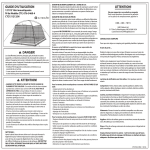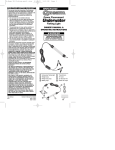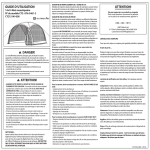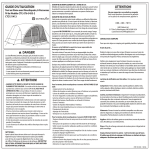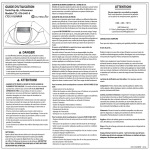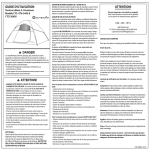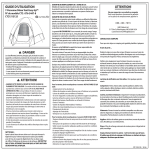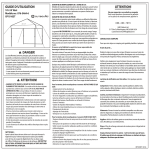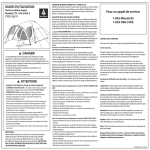Download OWNERS MANUAL NOTICE! DANGER! WARNING!
Transcript
OWNERS MANUAL 12’x12’ Screen House CTC Model: 076-5460-4 CTC151212SH TM MC TM MC DANGER! Stoves, lanterns, candles, grills, heaters and other fuel-burning devices produce carbon monoxide and will consume the available oxygen in a tent. Use of such devices in a tent may cause asphyxiation, carbon monoxide poisoning, and death or serious and permanent injuries. For this reason: - DO NOT use fuel-burning devices inside or near this product. - Your failure to follow this warning may cause death or serious and permanent injury to you or others. WARNING! - KEEP ALL FLAME AND HEAT SOURCES AWAY FROM THIS FABRIC. This product is made with flame-resistant fabric, which meets CPAI-84 specifications. IT IS NOT FIREPROOF! The fabric will burn if left in continuous contact with any flame source. The application of any foreign substance to the fabric may render the flame-resistant properties ineffective. - Anchor properly at all times and carefully consider campsite choice. Be aware of possible falling rocks or tree limbs, lightning strikes, flash floods, strong winds and other hazards which may cause harm to this product or its occupants. - Have a minimum of two adults for assembly. During assembly poles are under tension. If not held firmly in place during assembly, poles could break or flip up, possibly causing serious injury. - Safety glasses may be worn throughout the assembly process as an additional precaution. - Exercise care when using electric devices in and near tents. CLEANING: Allow dirt to dry on the fabric after a rainfall before lightly sweeping it off with a brush. For tougher stains, spray the area with water and lightly wipe it off with a few strokes. Do not use washer or dryer. DO NOT SCRUB THE FABRIC. ALWAYS MAKE SURE IT IS COMPLETELY DRY BEFORE REPACKING. CTC 7-DAY REPLACEMENT WARRANTY Unpack and inspect all contents for defects in workmanship and materials within 7 days of purchase. If any defects are found, return the product to the place of purchase, along with the proof of purchase, and it will be replaced free of charge. 1-YEAR REPLACEMENT PARTS WARRANTY This product carries a replacement parts warranty against defects in materials and workmanship for a period of 12 months from date of purchase. At its discretion, the manufacturer may provide replacement parts. Original purchaser will be required to provide proof of purchase. The consumer will be responsible for shipping costs incurred outside of the U.S. or Canada. Warranties DO NOT cover normal wear and tear, misuse, abuse, inclement weather conditions (i.e. wind, rain, hail, lightning, tornadoes or hurricanes) or other acts of God, mildew and rotting, damage or fading caused by prolonged exposure to UV rays. This warranty gives you specific legal rights. You may also have other rights which vary depending on locale. Under no circumstances shall the manufacturer be liable for any incidental or consequential damages. The tent is water-repellent. It is not waterproof. During heavy or continuous rain, some leakage may occur. Avoid contact between objects and the inside of the tent, as this may result in leakage at points of contact. In the event of seam leakage, apply a seam-sealer compound. Although our products are manufactured according to rigorous specifications, periods of wind or rain may loosen the stakes and cause the frame to sink into the ground. This will weaken the structure’s overall rigidity. Puddles may also form on the roof if the unit has not been assembled tightly. If pooling should occur, it is advisable to drain the fly to avoid possible damage to frame and fabric. Adjustment of guy lines may be necessary. In case of inclement weather, remove valuables and seek appropriate shelter. Intended for recreational use only. For your tent, screen house or canopy DO NOT... - Pitch near an open fire. - Use candles or open flames of any kind inside or near it. - Leave children unattended inside. - Use fuel-burning, oxygen-consuming devices (heaters, lanterns, cooking stoves or other flame sources) inside. - Refuel lamps, heaters or stoves inside. - Smoke inside. - Store flammable liquids inside. - Use water-repellent compounds other than those recommended for use on outdoor equipment. - Spray with insecticide. - Store on concrete floor. For your tent, screen house or canopy DO... - Always extinguish campfire before sleeping or leaving the area. - Exercise care when using electricity and lighting. - Make certain it is properly ventilated in all weather conditions. In extreme weather conditions, snow could obstruct airflow and cause asphyxiation. Clear frequently. - Anchor securely to provide additional security in changing climatic conditions. Snow pegs, skis and/or heavy rocks may be necessary to supplement stakes and guy lines. - Take down and store properly after camping. NOTICE! Do Not Return to Retail Store For Warranty consideration or for replacement parts call 888–280–7876 HKD Global Ltd 317 Elm St, Washington, MO 63090 USA [email protected] CAMPERS’ TIPS The key to an enjoyable camping experience is planning and preparation. Before you go … Research the area where you intend to camp. Prepare for any possible weather condition. Be aware of hazards and emergency protocol. Know the rules and regulations. Check out your equipment before your trip. Be sure your cook stove, lanterns, flashlights, air mattress, etc., are in good working order. Erect your tent to become familiar with setup. Once you’ve assembled your tent in a dry, well-ventilated area, apply seam-sealing compound to the stitching of the inside seams following manufacturer’s directions. Allow to dry thoroughly before storage. Reapply annually. Checklists are great planning tools. Here are some areas to consider. Camp setup: Tent, chairs, table, ground cloth, entrance mat, tarp, poles, rope, stakes, bungee cords, duct tape, zip ties, hammer/tools, bedding. Kitchen setup, food and beverages: Plan for transport, preparation, storage and disposal. Remember to pack fire-starting devices in waterproof containers, and bring pots, dishes, utensils, can opener, heavy-duty garbage bags and biodegradable soap. Store your food in lockers or out of sight in vehicles. Clothing: Be prepared for all your activities. Include a hat, sunglasses and quality socks. Dress in layers. Hygiene: Personal toiletries, rubber gloves, basic first aid items. Don’t forget your medications. Miscellaneous: Extra batteries, sewing kit, clothespins, dust pan/brush and insect-repellant. Be considerate of others, humans and wildlife. Remember to clean up and dispose of waste properly. “Leave no trace behind.” CTC151212SH 10/14 SCREEN HOUSE CTC151212SH(076-5460-4) Step 1: Verify package contents Step 2: Assemble poles 1) Assemble the screen house poles by placing fibreglass sections into the metal ferrules. Two poles are provided: Screen House : 1 each ASSEMBLY INSTRUCTIONS IMPORTANT NOTES: TM MC * Assemble your screen house before camping to become familiar with the assembly. 2 each (A) Main * Two people are recommended for set-up. Fibreglass Poles : 2 each (total) * Select a clean, level area for the campsite, free of debris and sharp objects, away from a natural watercourse. (A) Main - 2 each * To prevent damage to the zippers, unzip the doors and windows of the screen house prior to disassembly. Tent Stakes : 12 each Step 3: Spread out screen house, insert poles Step 4: Raise the screen house 1) Spread out screen house on flat, clean and level surface. Zippered openings should be closed for proper assembly. 2) Locate roof pole sleeves and insert two main poles (A) so the poles cross at the top of the screen house. Use the diagram below as a guide. 1) With one person at each end of assembled pole, lift the screen house. Place the bottoms of the leg onto the pins attached to the stake loops at the corners of the screen house. Repeat for the remaining pole. TM MC TM MC A A CTC151212SH 10/14 Step 5: Fasten hooks and stake screen house Step 6: Secure guy lines 1) Clip the plastic hooks on the screen house to the fibreglass pole frame. 2) Stake down the screen house by inserting a stake through the stake loops, located along the perimeter of the screen house. 3) Position the poles so the sod cloth around the perimeter of the screen house is taut but remains on the sod. Make certain the perimeter is even and squared. 4) Hammer the stakes into the ground at a 45° angle using a hammer or mallet. 1) Secure screen house using all guy lines and stakes. Screen house must be secured for proper function. TM MC Step 7: Fully assembled Screen house appears as shown. TM MC Step 8: Disassembly Step 9: Packing the screen house 1) To take down the screen house, disassemble in reverse order. 2) Be sure to leave doors and windows unzipped to avoid zipper damage. 3) Remove stakes with hammer or stake puller. DO NOT pull on tent. 4) Carefully disengage poles from pins. Push poles away from you through the sleeves to minimize risk of damage to tent or poles. 5) Keep poles and stakes together in bags provided. 1) Spread screen house flat, distribute evenly. 2) Fold into quarters not to exceed the length of pole bag. Fold tent into a rectangular shape. A Dimension A should be close to but not exceed the length of the pole bag. 3) Lay pole bag at opposite end from door. Tightly roll bag and skin forcing air through unzipped door. Front of tent (door unzipped) 4) Secure with ties and place in carry bag with stakes and accessories. 5) Screen house must be clean and dry before storage. Do not store on concrete floor. Be certain campfires are extinguished. Dispose of garbage appropriately. CTC151212SH 10/14 Screen House Floor size: Centre height: Weight: SPECIFICATIONS: 12’ x 12’ (3.65 x 3.65 m) 7’ (2.13 m) 8.19 lbs (3.72 kg) REPLACEMENT PARTS A KEY NO. A PART NO. DESCRIPTION QTY. REQ. MODEL NO. CTC 151212SH(076-5460-4) A Fibreglass Pole - Main HFP11-195f+352+202f,pf 2 Tent Stakes HMS4-7 12 TROUBLESHOOTING GUIDE PROBLEM SOLUTION 1. CONDENSATION Condensation occurs when warm moist air inside tent comes in contact with cooler outside air. Avoid touching walls to reduce contact leakage. Venting doors and windows will reduce condensation. Store wet clothing outside of tent. A battery powered fan may be helpful. Not applicable to screen houses. 2. SEAM LEAKAGE Apply a generous amount of seam sealer on inside seams. Seam sealer may be purchased at any local sporting goods store. 3. MILDEW To avoid mildew, store tent/screen house ONLY when thoroughly dry. However, if mildew occurs, use a soft bristle brush or sponge with mild dishwashing soap or Fels Naptha soap to clean. Let dry thoroughly, and a tent approved water repellent compound may be applied. 4. REPAIRING A TEAR For small tears, use a self-adhesive patch kit. We recommend a canvas or awning repair shop for larger tears. 5. FAULTY ZIPPER Zippers are self-repairing. If the zipper separates, you can move the slider to the beginning of the zipper tape and rework the zipper. 6. FADING FABRIC Do not leave up in direct sunlight longer than necessary. If left in sunlight for prolonged periods of time, fabric will fade and weaken. 7. FLOOR CONDENSATION A ground cloth under the floor helps prolong its life, provides additional insulation and moisture protection. The cloth should be smaller than the floor to prevent rain from running under the tent. Not applicable to screen houses. 8. USE OF STAKES Stakes should be installed at a 45° angle using a hammer or mallet. Stake loops should be kept taut without over-stretching fabric or webbing. This could cause tears or leakage. To remove safely, use a hammer or stake puller. Do not remove by pulling on the fabric. CTC151212SH 10/14




